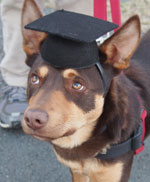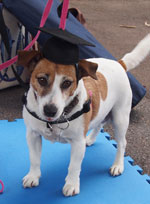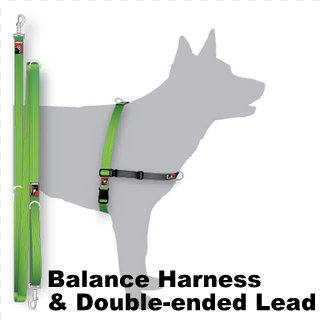Dog Walking and Training EquipmentAlso available, Enrichment Toys: Snuffle Mats and Snuffle Balls Pull Reducing Dog Walking HarnessBalance Harness Pack - pull reducing harness and double-ended lead set. The Balance Harness has a D-ring at the front (at the dog's chest) and another D-ring on the back. For dog's that pull on lead, attach the lead to the front ring so that some of the pulling energy is redirected back towards you rather than forward. Once you've trained your dog not to pull, then you can attach the lead to the back of the harness. The Balance Harness works with the Balance double-ended Lead. The unique and versatile Balance Lead has a hook and a handle on both ends! For strong dogs that pull on lead, attach the Balance lead to both the front and the back of the Balance Harness at the same time. This gives you safe control while you work on training your dog not to pull. When you attach the Balance Lead to just the front or back of the harness you can use the extra D-rings along the lead to adjusts its length from 1m to 2m and a couple of lengths in between.
I sell Australian Black Dog Wear products because I think they are excellent and they're not readily in shops. My prices are at least 20% below the recommended retail price. Please contact me to order.
About Dog Walking Equipment: Collars, Harnesses and HaltersMy preferred equipment for dog walking is a body harness, preferably a front attach or front and back attach harness (the Balance Harness). The problem with collars is that they can damage your dog's spine, trachea, thyroid gland, and even their eyes!* Also a dog can pull backwards and get out of a collar if he gets over excited or frightened. To avoid the dog escaping, the collar has to be uncomfortably tight. If you use a harness for walking all these problems are avoided. Also, your dog's collar can be comfortable and it's only purpose is to hold the ID tag (which is essential). You are welcome to bring your dog to class or private lessons on a collar if you prefer, so long as it is not a choker chain, as these are truly harmful, punishing and unnecessary. Head halters fit around a dog's nose, and are also known as Haltis. I very rarely have to use them because I find that using a suitable harness combined with training the dog not to pull are all that's needed. Head halters can be useful though for large dogs walked by small people, or as a very short term tool while training is taking place. Head halters must always be fitted by a trainer and the dog must be taught to willingly accept the halter. This can take a few days. It mustn't be forced onto a dog without this gradual acceptance training or he will paw at it to try to get it off and it will be counter-productive and punishing. Even if the dog is not pawing at the halter his body language is often subdued and stressed, which is not what you want. A dog should enjoy his walk without fear of pain from a head halter or choker chain. Be wary of trainers that routinely use head halters or choker chains. I consider it a sign of an unskilled trainer. *References: Is It Harmful to Attach a Leash to a Collar? and On the Danger of Dog Collars and Can a Collar Damage a Dog's Thyroid and Choke Collar Pathology and Flat Collars Risk Damage to Dogs’ Necks if They Pull or You Jerk the Leash
Also available, Enrichment Toys: Snuffle Mats and Snuffle Balls |
    |

